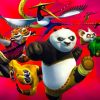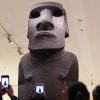ART NEWS
Meet Sadanam Harikumar, the multi-faceted artiste
Sadanam Harikumar, who has won the 2020 Akademi award for sculpture, is also a painter, musician, composer and dancer
Eyebrows were raised when Kerala Lalithakala Akademi announced its list of awardees for 2020. It included Kathakali artiste Sadanam Harikumar — but for sculpture. For many painters and artists, however, this did not come as a surprise — they had seen Harikumar’s art works at exhibitions and at the solo show he had organised with an Akademi grant. The moulding of this multi-talented artiste is linked to some institutions closely associated with the freedom movement. As a child born in Sadanam Kathakali Academy (1953), founded by his father, the veteran freedom fighter Sadanam Kumaran, training in the classical dance-theatre was a given. He donned the kachcha (loin cloth) while in the third standard and had his arangetram when he was in the fifth standard. He ascribes all his achievements in Kathakali — an accomplished performer, musician, playwright (with 19 plays to his credit) and costume designer — to the doyen Keezhpadam Kumaran Nair Asan, who was at the helm of the Kathakali department in the Academy then. “My guru is the most resourceful exponent of Kathakali I have ever met in my life and he has had ample influence on my artistic career,” Harikumar has said earlier.
Sadanam Harikumar giving finishing touches to the bust of Thekkinkattil Ravunni Nair
Before the Kathakali Academy was established, his father had founded Gandhi Seva Sadanam (1946) as part of the freedom movement. This institution had different courses for teaching people crafts for self-reliance. Working on clay was one such. As a child, Harikumar mingled with the artisans and learnt to sculpt in clay. He soon realised his flair for the medium, and even won prizes in school competitions. Later, while in Christ College, Irinjalakuda, an institution known for its extra-curricular activities, his talents bloomed in full. In 1989, Harikumar became a lecturer in the Kathakali department in Santiniketan, another trailblazing institution that emerged from the Independence Movement. The extent to which this campus motivated his artistic propensity is beyond description. Alongside his classes, he began making terracotta sculptures in the department of Fine Arts. The veteran K. G. Subramaniam in the department wondered how he could create such unique works by merely observing. . By the time Harikumar left Shantiniketan in 1994 due to health issues, he was an accomplished sculptor.Back home, it took more than a year for him to recover completely. He soon got back to sculpting and joined the Sadanam Teachers’ Training School as lecturer.By this time, Harikumar was confident enough to try his hand at portraits. He painted ten legendary Kathakali artistes, including Pattikkamthodi Ravunni Menon, Keezhpadam Kumaran Nair, Thekkinkattil Ramunni Nair, Kalamandalam Ramankutty Nair, Vazhankada Kunchu Nair, Thiruvalwamala Vankichan Swamy, Moothamana Kesavan Namboodiri and Mundaya Venkitakrishna Bhagavathar. Perhaps the last in the series was of C. S. Krishna Iyer, his guru in Carnatic music. He also made busts of his parents.
The Karmayogam silpam that won him the award
The piece that fetched him the Lalithakala Akademi award is titled ‘Karmayogam’ and shows a resurrected man with a wreath on his chest and crows milling around. The six-foot sculpture depicts ramifications of life and death.Foray into paintingHarikumar’s foray into painting also happened in Santiniketan. Though he started with oil, he moved to acrylic and recently to Photoshop painting. Sculptor, painter, a Kathakali and Bharatanatyam dancer, musician and composer (he has 30 Malayalam songs to his credit), Harikumar’s achievements mirror the dialogue between Sage Markandeya and King Vajra in the Vishnudharmothara Purana, when the king started by wanting to learn sculpture and the sage said he had to learn painting first, for which he had to learn dance, for which he must know instrumental music, which in turn required a knowledge of singing. And thus was born a multi-dimensional talent.The writer and culture critic is a trained musician.











